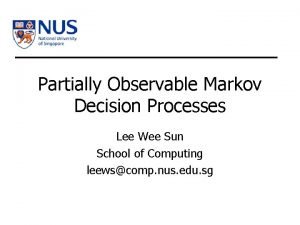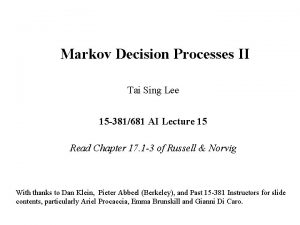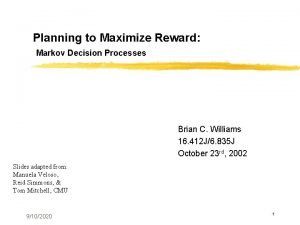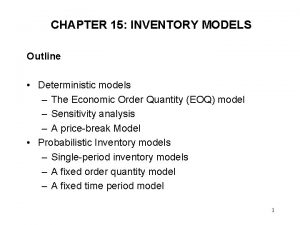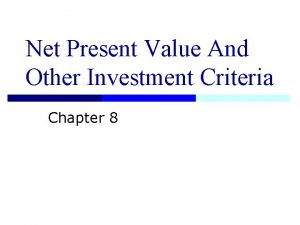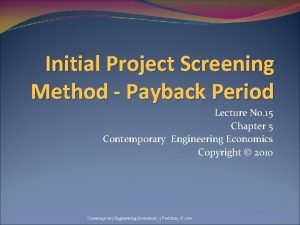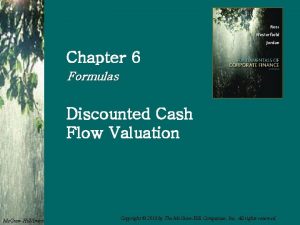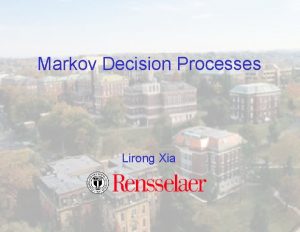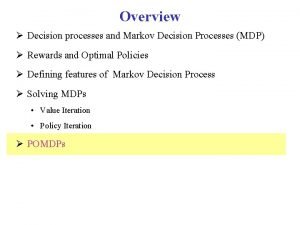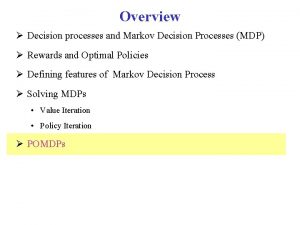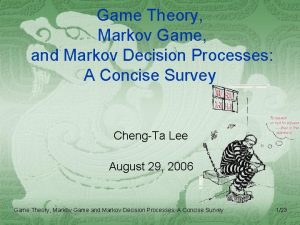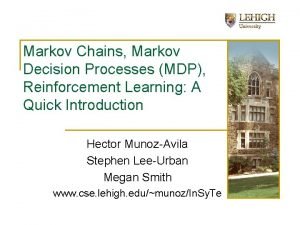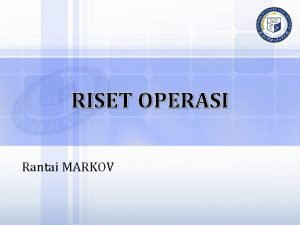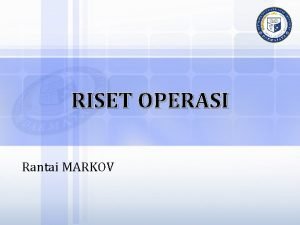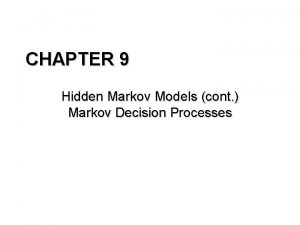Discounted Deterministic Markov Decision Processes and Discounted AllPairs

![Markov Decision Processes [Bellman ’ 57] [Howard ’ 60] … States Actions Costs/Rewards Distributions Markov Decision Processes [Bellman ’ 57] [Howard ’ 60] … States Actions Costs/Rewards Distributions](https://slidetodoc.com/presentation_image_h/b6a5a2a1c0bb3aa6f27df8a37852f123/image-2.jpg)
![Markov Decision Processes [Bellman ’ 57] [Howard ’ 60] … i-th action taken Limiting Markov Decision Processes [Bellman ’ 57] [Howard ’ 60] … i-th action taken Limiting](https://slidetodoc.com/presentation_image_h/b6a5a2a1c0bb3aa6f27df8a37852f123/image-3.jpg)







![Karp’s algorithm for finding minimum mean cost cycles [Karp’ 78] dk(u) - the smallest Karp’s algorithm for finding minimum mean cost cycles [Karp’ 78] dk(u) - the smallest](https://slidetodoc.com/presentation_image_h/b6a5a2a1c0bb3aa6f27df8a37852f123/image-11.jpg)




![The Andersson-Vorobyov algorithm [’ 06] We want to solve the following equations: Start with The Andersson-Vorobyov algorithm [’ 06] We want to solve the following equations: Start with](https://slidetodoc.com/presentation_image_h/b6a5a2a1c0bb3aa6f27df8a37852f123/image-16.jpg)
![The Andersson-Vorobyov algorithm [’ 06] For each vertex, select an outgoing tight edge, if The Andersson-Vorobyov algorithm [’ 06] For each vertex, select an outgoing tight edge, if](https://slidetodoc.com/presentation_image_h/b6a5a2a1c0bb3aa6f27df8a37852f123/image-17.jpg)



![Discounted All-Pairs Shortest Paths Naïve algorithm runs in O(n 4)-time [Papadimitriou-Tsitsiklis ’ 87] A Discounted All-Pairs Shortest Paths Naïve algorithm runs in O(n 4)-time [Papadimitriou-Tsitsiklis ’ 87] A](https://slidetodoc.com/presentation_image_h/b6a5a2a1c0bb3aa6f27df8a37852f123/image-21.jpg)


- Slides: 23

Discounted Deterministic Markov Decision Processes and Discounted All-Pairs Shortest Paths Omid Madani – SRI International, AI center Mikkel Thorup – AT&T Labs, Research Uri Zwick – Tel Aviv University
![Markov Decision Processes Bellman 57 Howard 60 States Actions CostsRewards Distributions Markov Decision Processes [Bellman ’ 57] [Howard ’ 60] … States Actions Costs/Rewards Distributions](https://slidetodoc.com/presentation_image_h/b6a5a2a1c0bb3aa6f27df8a37852f123/image-2.jpg)
Markov Decision Processes [Bellman ’ 57] [Howard ’ 60] … States Actions Costs/Rewards Distributions … Strategies Objectives
![Markov Decision Processes Bellman 57 Howard 60 ith action taken Limiting Markov Decision Processes [Bellman ’ 57] [Howard ’ 60] … i-th action taken Limiting](https://slidetodoc.com/presentation_image_h/b6a5a2a1c0bb3aa6f27df8a37852f123/image-3.jpg)
Markov Decision Processes [Bellman ’ 57] [Howard ’ 60] … i-th action taken Limiting average version Discounted version Discount factor Optimal positional strategies can be found using LP Is there a strongly polynomial time algorithm?

Deterministic MDPs Limiting average version Discounted version One player, deterministic actions

Deterministic MDPs = “The truck problem” Traverse a single edge each day Maximize profit per day (in the “long run”)

Discounted Deterministic MDPs = “The discounted/unreliable truck problem” Traverse a single edge each day Maximize (expected) total profit At each day, truck breaks down with prob. 1 λ

Deterministic MDPs – limiting average version For each vertex, find a cycle of minimum mean cost reachable from it [Karp ’ 78] [Young-Tarjan-Orlin ’ 91] O(mn) O(mn+n 2 log n) Better performance in practice

Discounted DMDPs … Both the path and the cycle matter As 1, approaches the limiting average case

Discounted DMDPs – optimal strategies

Discounted DMDPs - results Authors Running time Papadimitriou-Tsitsiklis ’ 87 Madani ’ 02 Andersson-Vorobyov ’ 06 O(n 4) O(mn 2 log n) O(mn 2) New O(mn) O(mn+n 2 log n) n – number of states/vertices m – number of actions/edges
![Karps algorithm for finding minimum mean cost cycles Karp 78 dku the smallest Karp’s algorithm for finding minimum mean cost cycles [Karp’ 78] dk(u) - the smallest](https://slidetodoc.com/presentation_image_h/b6a5a2a1c0bb3aa6f27df8a37852f123/image-11.jpg)
Karp’s algorithm for finding minimum mean cost cycles [Karp’ 78] dk(u) - the smallest cost of a k-edge path starting at u Complexity: O(mn) A cheapest n-edge path starting at v There is a vertex v such that all cycles on Pn(v) are optimal [Madani ’ 00]

Discounted DMDPs x(u) - The smallest discounted cost of an infinite path starting at u Each vertex has an optimal outgoing edge

A Karp-like/Value-iteration algorithm for DMDPs dk(u) - smallest discounted cost of a k-path starting at u Claim 1: For every v V we have x(v) y(v) Claim 2: On every optimal cycle there is at least one vertex v such that x(v) = y(v) How do we know who are the optimal cycles?

Discounted DMDPs – optimal strategies

A Karp-like algorithm for DMDPs First Bellman-Ford phase: k = 1, 2, …, n A Karp phase: Second Bellman-Ford phase: k = 1, 2, …, n Theorem: For every v V we have x(v)=yn(v)
![The AnderssonVorobyov algorithm 06 We want to solve the following equations Start with The Andersson-Vorobyov algorithm [’ 06] We want to solve the following equations: Start with](https://slidetodoc.com/presentation_image_h/b6a5a2a1c0bb3aa6f27df8a37852f123/image-16.jpg)
The Andersson-Vorobyov algorithm [’ 06] We want to solve the following equations: Start with values that satisfy: If each vertex has a tight out-going edge, we are done Otherwise, increase values, in a controlled manner
![The AnderssonVorobyov algorithm 06 For each vertex select an outgoing tight edge if The Andersson-Vorobyov algorithm [’ 06] For each vertex, select an outgoing tight edge, if](https://slidetodoc.com/presentation_image_h/b6a5a2a1c0bb3aa6f27df8a37852f123/image-17.jpg)
The Andersson-Vorobyov algorithm [’ 06] For each vertex, select an outgoing tight edge, if any. The result is a pseudo-forest. Cannot Ideal! become tight val(u) c(u, v) + val(v) Tight for pseudo-forest edges val[u] + depth[u] t for every u not in a pseudo-tree Pseudo-forest edges remain tight, for every t Find the smallest t for which a non-pseudo-forest edge becomes tight Sum of depths increases at most n 2 iterations O(mn 2) time

Speeding-up the algorithm Do not reset the clock after each iteration The ‘time’ at which the edge (u, v) becomes tight

An O(mn+n 2 log n) algorithm We would like to use Fibonacci heaps Unfortunately, time(u, v) may increase, as well as decrease Luckily, time(u) = minv time(u, v) can only decrease The resulting algorithm is similar to the algorithm of [Young-Tarjan-Orlin ’ 91] The Running time ‘typically’ (m + n log n) ? ? ?

Discounted All-Pairs Shortest Paths a a b b c Shortest paths may be ‘infinite’ d The prefix of a shortest path is not necessarily a shortest path!
![Discounted AllPairs Shortest Paths Naïve algorithm runs in On 4time PapadimitriouTsitsiklis 87 A Discounted All-Pairs Shortest Paths Naïve algorithm runs in O(n 4)-time [Papadimitriou-Tsitsiklis ’ 87] A](https://slidetodoc.com/presentation_image_h/b6a5a2a1c0bb3aa6f27df8a37852f123/image-21.jpg)
Discounted All-Pairs Shortest Paths Naïve algorithm runs in O(n 4)-time [Papadimitriou-Tsitsiklis ’ 87] A randomized O*(m 1/2 n 2)-time algorithm

Open problems ● Equivalence of non-discounted DMDPs and discounted DMDPs? ● o(mn)-time algorithms? ● Different discount factors for different edges? ● (Non-deterministic) Markov Decision Processes?

THE END
 Puterman markov decision processes
Puterman markov decision processes Objectives of decision making
Objectives of decision making Slidetodoc.com
Slidetodoc.com Mdp example
Mdp example Markov decision process merupakan tuple dari
Markov decision process merupakan tuple dari Markov decision
Markov decision Markov decision
Markov decision Markov decision
Markov decision Markov decision process
Markov decision process Tai sing lee
Tai sing lee Value iteration
Value iteration Concurrent processes are processes that
Concurrent processes are processes that Wharton risk management program
Wharton risk management program Decision table and decision tree examples
Decision table and decision tree examples Deterministic demand vs stochastic demand
Deterministic demand vs stochastic demand Is inventory a stock
Is inventory a stock Deterministic and stochastic inventory models
Deterministic and stochastic inventory models What is the formula for profitability index
What is the formula for profitability index Project screening example
Project screening example Payback equation
Payback equation How to calculate the discounted payback period
How to calculate the discounted payback period Discounted cash
Discounted cash Chapter 6 discounted cash flow valuation
Chapter 6 discounted cash flow valuation Discounted abnormal earnings model
Discounted abnormal earnings model








